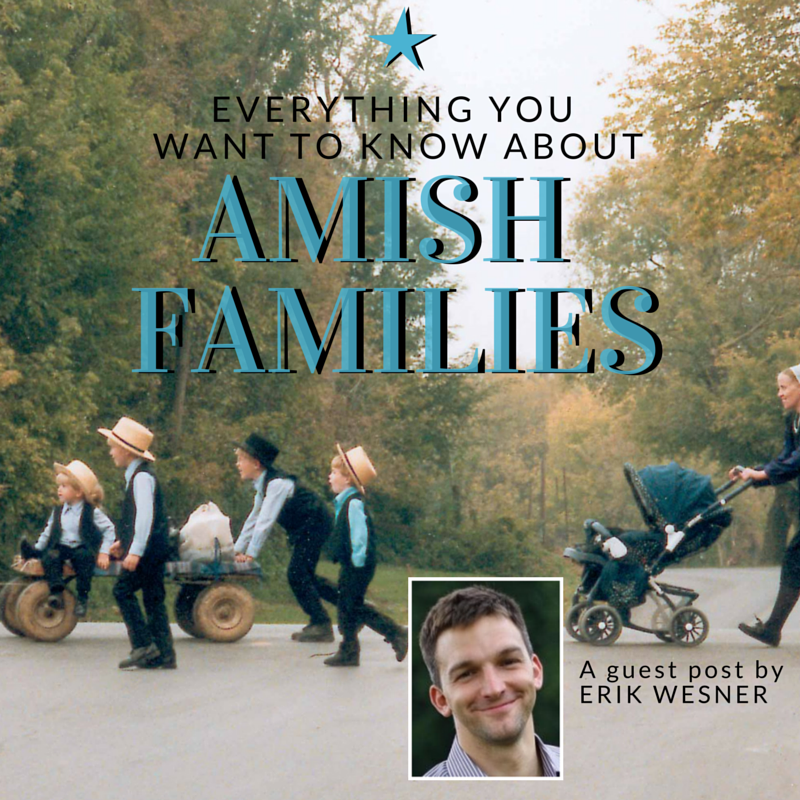
Everything You Want to Know About: Amish Families
We’re welcoming Erik Wesner, author of Success Made Simple: An Inside Look at Why Amish Businesses Thrive, back to the Timber to Table blog to tell us about the (extensive!) Amish family unit – you may be surprised by the similarity between Amish families and your own!
Go on, Erik –
Family Values

Amish families are large and encouraged to stay together, spending time learning the spiritual model and supporting one another
Family Life is the name of perhaps the most widely-read Amish publication, and the title is a good one—reflecting the great value of family to the Amish. While Amish families are not perfect, a number of what we might consider old-fashioned values remain highly important in the Amish family.
First, divorce is not sanctioned by the Amish, and divorcing a spouse can be grounds for excommunication from the church. Dysfunctional families certainly do exist among the Amish, but absentee fathers, single-parent or split households are not the norm that they’ve become in much of the rest of society.
Amish families are large. They believe in the injunction in the Book of Genesis to “be fruitful and multiply”, and families of 6 to 8 children are typical (with some communities averaging even 8 or 9 children per family). Children are considered a great blessing and Amish individuals enjoy large extended families, with dozens of cousins, numerous aunts and uncles, and many siblings.
Family time is important for the Amish. Doing things together allows parents to be a good example to children, both in the sense of learning a work ethic and also as a spiritual model. Farming has traditionally been considered the ideal occupation by Amish. This is due in part to the fact that it allows fathers to be at home working together with their wives and children.
Despite this feeling, farming has dwindled in some Amish settlements, though many have opened home businesses instead—which can provide similar benefits in terms of time spent together and instilling a work ethic in the next generation.
Starting a Family

Amish children are typically surrounded by siblings, cousins, and other family, so they always feel a sense of belonging [and yes, I really just wanted to use a picture of adorable ducklings here]
Children are given responsibility at an early age, with most learning a strong work ethic. Given the size of Amish extended families, an Amish child is surrounded by older and younger siblings, aunts, uncles, and grandparents, who in many cases live nearby, so they rarely want for companionship and playmates.
Amish children live at home, typically until marriage. They attend school from the 1st to the 8th grades, after which they graduate, and at age 14 or 15 begin working (often at home or for neighbor’s businesses, though the types of tasks they can perform are limited by safety regulations in some cases). It’s typical that Amish children contribute their paychecks to the household budget until the age of 21. At marriage, Amish parents help their children get started in life, in some cases helping finance a home or farm purchase.
Parental Roles

Parental and family roles seem very traditional to outsiders – males laboring outside the home, the women and female children playing supportive roles inside
Amish parents have distinct roles in the home. The male is considered the head of household, a stance Amish find support for in Scripture. He is also usually the main breadwinner (though Amish women in some cases contribute significantly to the household finances). He is the public voice of the family as well, and in some cases takes other leadership roles such as in the ministry if chosen, or in lay leadership – for example serving on a parochial school board or other committees.
Women have numerous important roles to fulfill as well. Amish consider a man’s wife his “helpmeet”, his primary support in this life. She is a mother, and in some cases (for example, when Amish men work away from home) may have the more prominent influence in raising the children. She is the household manager, responsible for maintaining the home, cooking food (often with help from the children), raising and canning vegetables and fruits from the substantial gardens found at most Amish homes, and may fulfill other roles such as helping handle finances for a home business, doing farm chores, and maintaining correspondence with other Amish via letter writing.
The Home

In Amish family homes, technology is out and large spaces for church and community gathering are in
The Amish home is the center of family life and reflects both the emphasis on family as well as the given community’s church standards (some homes are fancier, or plainer, as a result). Amish homes are generally large, with numerous rooms, spacious common areas such as living rooms and kitchens, and sizable basements, which can provide a space for gatherings such as Sunday church services which most Amish families host at least once per year.
Amish homes may be heated and lit in a variety of ways, depending on the local church rules, including using liquid propane or kerosene lighting, and with wood stoves commonly used for warmth. The technology homes contain varies as well—for example, some Amish keep their food cold using propane or natural gas refrigerators, while others rely on iceboxes. Most have indoor plumbing and bathrooms, but some—the most conservative—do not.
All Amish, wary of worldly influences, seek to keep certain technologies out of the home, including television, radio, and computers. Instead, Amish homes typically contain wholesome reading material for children, including Bible stories, Amish publications, and other books.
Families are also the building blocks, in one sense, of the Amish church. Typically, 25 to 35 Amish families make up a congregation (also known as a “church district”).
Church is held at the homes of members. This means families get to know each other more closely, visiting each household in the congregation at least once per year. Outside of family and close friends, Amish tend to know the people in their church district best, through not only regular attendance at church service but at other events.
Family Strength Based on Deeply-held Values

Biblical and cultural beliefs, plus a strong emphasis on traditional groups activities help keep Amish families strong
Outsiders tend to admire Amish families – for their strong family lives, well-behaved children, or because they remind us of “how things used to be”. It’s no accident we have these perceptions, which in many cases are probably accurate.
Amish emphasize certain values that lead to these family characteristics–both Biblical beliefs (promoting large families, an emphasis on selflessness, brotherly love, and other Christian values, forbidding divorce) and cultural (limited technology, which keeps focus on the family), and emphasizing traditional group activities like games, singing, and so on, rather than individualistic pursuits).
Some wonder how to capture these aspects in their own lives. It’s possible, yet it’s important to remember that these are the fruits of commitments Amish have made to their faith, culture and communities. Replicating what Amish families have may take changing one’s life in uncomfortable ways—not by becoming Amish, but making similar sacrifices and commitments. It’s not always easy, but the Amish certainly believe it is worth it.
Erik Wesner is the author of Success Made Simple: An Inside Look at Why Amish Businesses Thrive, and editor of the Amish America website.






Thank you!
My question is, Does each family have chickens, hogs, cows, garden? or Is there one family sect, that takes care of the cows for all of their families etc?
The reason I ask, is Stantonville Tn. I don’t see any chickens, hogs, cows at any of their homes. At one of the homes, they sell milk to the public.
Hello,
The practices at Amish homes can vary. Some are dairy farms, some focus on produce, others raise poultry. Here’s a helpful link to http://www.amishamerica.com that can tell you more.
https://amishamerica.com/what-foods-and-crops-do-amish-farmers-produce/
Thank you for your question and for visiting us on Timber to Table.